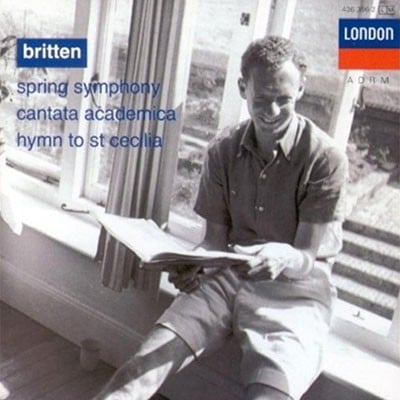Cantata Academica, Carmen Basiliense
op. 62 (1959)compiled by Bernhard Wyss (L)
2(II=picc).2.2.2-4.2.3.1-timp.perc(4):glsp/t.bells/xyl/cyms/tam-t/
tgl/tpl.bl/BD/SD/tamb-2(1)harps-pft(=cel ad lib)-strings
Abbreviations (PDF)
Boosey & Hawkes
The title of this work is tongue-in-cheek, referring not only to the circumstances of its commission (for the 500th anniversary of the University of Basle in 1959), but also to the fact that the work is based on a twelve-note theme. In twelve movements (and recapitulation of the opening Corale), each of which centres on a different pitch of the series, this occasional cantata is one of Britten’s most joyfully ebullient works.
Choral level of difficulty: Level 4 (5 greatest)
Britten’s genius lifts this work above being just a worthy celebration of the 500th anniversary of the foundation of Basle University. It is tongue-in-cheek and mockingly non-academic while referring all the time to academic musical forms and formulae. It is written in two parts (everything is in the statutory Latin including the titles of the parts – Pars I and Pars II). The titles of the movements show Britten’s intention to show off a wide variety of techniques. Here are some examples: Chorale/Alla Rovescio (the theme is given and responded to with the same melody upside down)/Recitativo/Tema seriale con fuga/Canone ed ostinato. There is a good deal of humour here.
There are seven movements in Pars I and six in Pars II. The tenor soloist is given three florid recitatives, accompanied only by a piano, which act as bridges between other orchestrally accompanied movements. Of these the most noteworthy are the Arioso con canto popolare for soprano solo with tenors and basses who hum a student song; another terrific Britten scherzo; and a wonderfully raucous final pair of movements (Canon ed ostinato and Corale con canto) where Britten seems to be aping the Vivat Regina! cries in Parry’s I was glad or encouraging the kind of noisy ‘I’m from the best university’ kind of student touchline shout. This has outrageously high notes for the tenors (top B) which further endorse this feeling. There are real echoes of the Spring Symphony (see separate entry) final movement here which are further underlined by the last section of the Cantata which brings in the bells, piano, huge percussion and the inevitable chorale in which the choir sings ‘that a free academy may thrive in a free community, for ever the ornament and treasure of illustrious Basle’.
This may not be Britten at his most soul-searching but, as always, there is plenty here to enjoy, especially if the work is not taken too seriously. It is a celebratory, occasional piece and it could be well taken up by other academic establishments celebrating big anniversaries. The chorus parts are not very difficult, though they do present challenges for the choir – not least in having tenors capable of those very high notes at the end. The Tema seriale con fuga is sinewy and needs careful tuning. It also has the subject regularly given upside down after its initial sounding by the basses. All good fun.
Repertoire note by Paul Spicer

London Symphony Orchestra and Chorus/George Malcolm
(p) and (c) Decca Classics
Decca 475 6040

